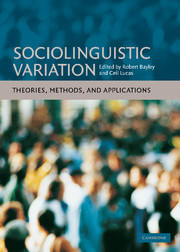Book contents
- Frontmatter
- Contents
- 1 List of figures
- 2 List of tables
- Acknowledgments
- Notes on editors and contributors
- Introduction
- Part 1 THEORIES
- Part 2 METHODS
- Part 3 APPLICATIONS
- 12 Sociolinguistic variation and education
- 13 Lessons learned from the Ebonics controversy: implications for language assessment
- 14 Variation, versatility, and Contrastive Analysis in the classroom
- 15 Social-political influences on research practices: examining language acquisition by African American children
- 16 Sociolinguistic variation and the law
- 17 Attitudes toward variation and ear-witness testimony
- Afterword: Walt Wolfram and the study of sociolinguistic variation
- References
- Index
14 - Variation, versatility, and Contrastive Analysis in the classroom
Published online by Cambridge University Press: 16 February 2010
- Frontmatter
- Contents
- 1 List of figures
- 2 List of tables
- Acknowledgments
- Notes on editors and contributors
- Introduction
- Part 1 THEORIES
- Part 2 METHODS
- Part 3 APPLICATIONS
- 12 Sociolinguistic variation and education
- 13 Lessons learned from the Ebonics controversy: implications for language assessment
- 14 Variation, versatility, and Contrastive Analysis in the classroom
- 15 Social-political influences on research practices: examining language acquisition by African American children
- 16 Sociolinguistic variation and the law
- 17 Attitudes toward variation and ear-witness testimony
- Afterword: Walt Wolfram and the study of sociolinguistic variation
- References
- Index
Summary
Introduction
A fundamental principle of variation theory, from its inception more than forty years ago, is that linguistic variation is the norm rather than the exception in human language use. Indeed, it was the weakness of the standard tools for analyzing such variation in linguistics (free variation and categorical conditioning), pitted against the strength and ubiquity of variation in language, that led to the development of modern sociolinguistics, with its concepts of inherent variability, quantitative and variable rule analysis, attentiveness to the social and stylistic dimensions of language use, and so on.
In American and other schools around the world, however, teachers have often sought to limit the linguistic variation of their students, deeming non-standard or vernacular varieties unacceptable for classroom (sometimes even playground) use, and eschewing literary materials or pedagogical approaches that refer to or use such varieties. The motivation for this is understandable: teachers and parents alike usually want to ensure that students acquire the standard variety associated with academic success and upward socioeconomic mobility. But the approach is ironic since some of the most successful authors and poets – Chinua Achebe, Robert Burns, James Joyce, V. S. Naipaul, Raja Rao, and Alice Walker, to name half a dozen who write in English – draw creatively on both their standard and vernacular varieties. Moreover, the experimental evidence we have on this point (see below) suggests that outlawing or ignoring the vernacular is less effective at helping students acquire the standard variety than recognizing it and studying its similarities to and differences from the standard via Contrastive Analysis (CA) and other methods.
- Type
- Chapter
- Information
- Sociolinguistic VariationTheories, Methods, and Applications, pp. 276 - 296Publisher: Cambridge University PressPrint publication year: 2007
- 9
- Cited by



